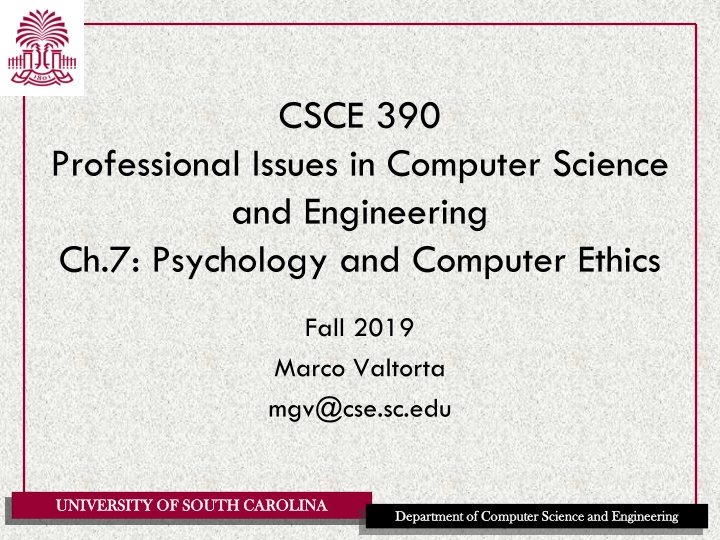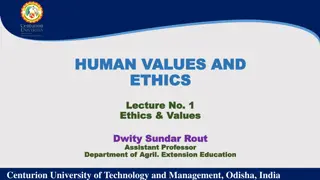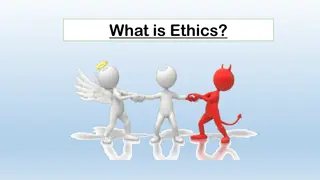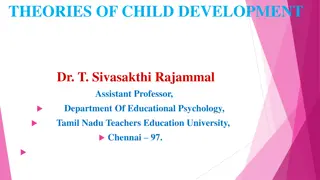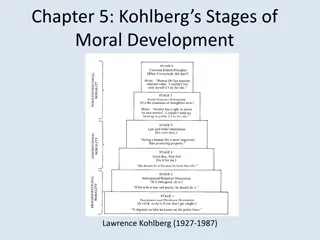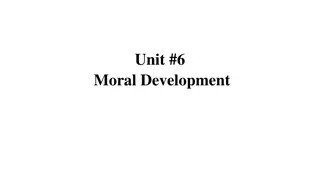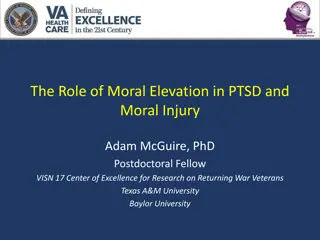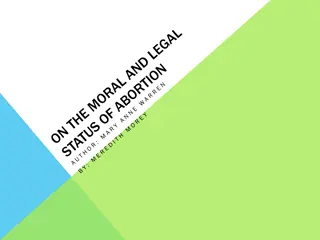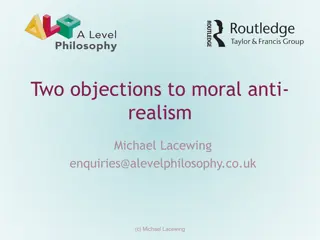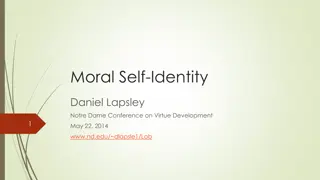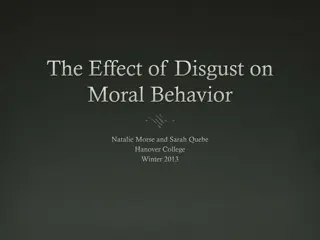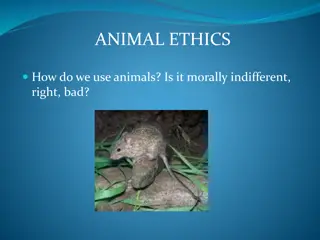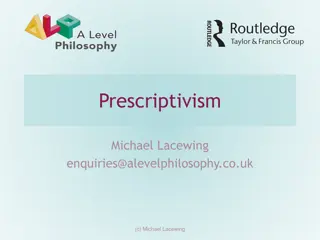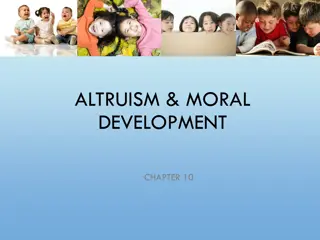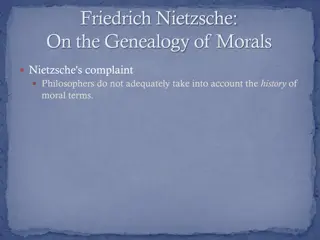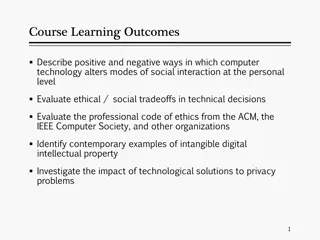Kohlberg's Stages of Moral Development in Computer Ethics
This content explores Kohlberg's Stages of Moral Development in the context of computer ethics, focusing on an ethical dilemma involving Heinz stealing a drug to save his wife. It discusses the different levels of moral reasoning, from pre-conventional to post-conventional morality, and how individuals' ethical decisions can be analyzed based on these stages.
Download Presentation

Please find below an Image/Link to download the presentation.
The content on the website is provided AS IS for your information and personal use only. It may not be sold, licensed, or shared on other websites without obtaining consent from the author.If you encounter any issues during the download, it is possible that the publisher has removed the file from their server.
You are allowed to download the files provided on this website for personal or commercial use, subject to the condition that they are used lawfully. All files are the property of their respective owners.
The content on the website is provided AS IS for your information and personal use only. It may not be sold, licensed, or shared on other websites without obtaining consent from the author.
E N D
Presentation Transcript
CSCE 390 Professional Issues in Computer Science and Engineering Ch.7: Psychology and Computer Ethics Fall 2019 Marco Valtorta mgv@cse.sc.edu UNIVERSITY OF SOUTH CAROLINA UNIVERSITY OF SOUTH CAROLINA Department of Computer Science and Engineering Department of Computer Science and Engineering
Kohlbergs Stages of Moral Development, Ch.7[B] Version Level Stage Social Orientation Pre-conventional 1 Obedience and Punishment (child) 2 Individualism/Instrumentalism Conventional 3 Good boy/Good girl (adolescent) 4 Law and Order Post-conventional 5 Social Contract (adult) 6 Principled Conscience UNIVERSITY OF SOUTH CAROLINA UNIVERSITY OF SOUTH CAROLINA Department of Computer Science and Engineering Department of Computer Science and Engineering
Kohlbergs Stages of Moral Development http://www.character-education.info/Articles/stages_of_moral_development.htm, accessed 2010-02-11 The stages in this table are different from the ones in the textbook. UNIVERSITY OF SOUTH CAROLINA UNIVERSITY OF SOUTH CAROLINA Department of Computer Science and Engineering Department of Computer Science and Engineering
An Ethical Dilemma Used by Kohlberg Heinz Steals the Drug In Europe, a woman was near death from a special kind of cancer. There was one drug that the doctors thought might save her. It was a form of radium that a druggist in the same town had recently discovered. The drug was expensive to make, but the druggist was charging ten times what the drug cost him to make. He paid $200 for the radium and charged $2,000 for a small dose of the drug. The sick woman's husband, Heinz, went to everyone he knew to borrow the money, but he could only get together about $ 1,000 which is half of what it cost. He told the druggist that his wife was dying and asked him to sell it cheaper or let him pay later. But the druggist said: No, I discovered the drug and I'm going to make money from it. So Heinz got desperate and broke into the man's store to steal the drug-for his wife. Should the husband have done that? (Kohlberg, 1963, p. 19; quoted in: W.C. Crain. (1985). Theories of Development. Prentice-Hall. pp. 118-136.) UNIVERSITY OF SOUTH CAROLINA UNIVERSITY OF SOUTH CAROLINA Department of Computer Science and Engineering Department of Computer Science and Engineering
Preconventional Morality (Level 1): Obedience and Punishment (Stage 1) Heinz was wrong to steal the drug because "It's against the law," or "It's bad to steal," as if this were all there were to it. When asked to elaborate, the child usually responds in terms of the consequences involved, explaining that stealing is bad "because you'll get punished" (Kohlberg, 1958b). Although the vast majority of children at stage 1 oppose Heinz s theft, it is still possible for a child to support the action and still employ stage 1 reasoning. For example, a child might say, "Heinz can steal it because he asked first and it's not like he stole something big; he won't get punished" (see Rest, 1973). Even though the child agrees with Heinz s action, the reasoning is still stage 1; the concern is with what authorities permit and punish. (W.C. Crain. (1985). Theories of Development. Prentice-Hall. pp. 118-136.) UNIVERSITY OF SOUTH CAROLINA UNIVERSITY OF SOUTH CAROLINA Department of Computer Science and Engineering Department of Computer Science and Engineering
Preconventional Morality (Level 1): Individualism and Exchange (Stage 2) At this stage children recognize that there is not just one right view that is handed down by the authorities. Different individuals have different viewpoints. "Heinz," they might point out, "might think it's right to take the drug, the druggist would not." Since everything is relative, each person is free to pursue his or her individual interests. fair exchange (deals): If you scratch my back, I'll scratch yours. Respondents at stage 2 are still said to reason at the preconventional level because they speak as isolated individuals rather than as members of society. They see individuals exchanging favors, but there is still no identification with the values of the family or community. (W.C. Crain. (1985). Theories of Development. Prentice-Hall. pp. 118-136.) UNIVERSITY OF SOUTH CAROLINA UNIVERSITY OF SOUTH CAROLINA Department of Computer Science and Engineering Department of Computer Science and Engineering
Conventional Morality (Level 2): Good Interpersonal Relationships (Stage 3) Heinz was right to steal the drug because He was a good man for wanting to save her, and His intentions were good, that of saving the life of someone he loves. Even if Heinz doesn't love his wife, he should steal the drug because I don't think any husband should sit back and watch his wife die. It was really the druggist's fault, he was unfair, trying to overcharge and letting someone die. Heinz loved his wife and wanted to save her. I think anyone would. I don't think they would put him in jail. The judge would look at all sides, and see that the druggist was charging too much. This answer deserves the label conventional morality because it assumes that the attitude expressed would be shared by the entire community anyone would be right to do what Heinz did (W.C. Crain. (1985). Theories of Development. Prentice-Hall. pp. 118-136.) UNIVERSITY OF SOUTH CAROLINA UNIVERSITY OF SOUTH CAROLINA Department of Computer Science and Engineering Department of Computer Science and Engineering
Conventional Morality (Level 2): Maintaining the Social Order (Stage 4) I don't want to sound like Spiro Agnew, law and order and wave the flag, but if everybody did as he wanted to do, set up his own beliefs as to right and wrong, then I think you would have chaos. The only thing I think we have in civilization nowadays is some sort of legal structure which people are sort of bound to follow. In stage 4, subjects make moral decisions from the perspective of society as a whole, they think from a full-fledged member-of- society perspective. Stage 1 children say, It's wrong to steal and It's against the law, but they cannot elaborate any further, except to say that stealing can get a person jailed. Stage 4 respondents, in contrast, have a conception of the function of laws for society as a whole (W.C. Crain. (1985). Theories of Development. Prentice-Hall. pp. 118-136.) UNIVERSITY OF SOUTH CAROLINA UNIVERSITY OF SOUTH CAROLINA Department of Computer Science and Engineering Department of Computer Science and Engineering
Postconventional Morality (Level 3): Social Contract and Individual Rights (Stage 5) It is the husband's duty to save his wife. The fact that her life is in danger transcends every other standard you might use to judge his action. Life is more important than property. From a moral standpoint Heinz should save the life of even a stranger, since to be consistent, the value of a life means any life. When asked if the judge should punish Heinz, the subject replied: Usually the moral and legal standpoints coincide. Here they conflict. The judge should weight the moral standpoint more heavily but preserve the legal law in punishing Heinz lightly. Morality and rights take some priority over particular laws. (W.C. Crain. (1985). Theories of Development. Prentice-Hall. pp. 118-136.) UNIVERSITY OF SOUTH CAROLINA UNIVERSITY OF SOUTH CAROLINA Department of Computer Science and Engineering Department of Computer Science and Engineering
Postconventional Morality (Level 3): Universal Principles (Stage 6) In the Heinz dilemma, all parties--the druggist, Heinz, and his wife--take the roles of the others. (Recall Rawls s Veil of ignorance ) If the druggist did this, even he would recognize that life must take priority over property; for he wouldn't want to risk finding himself in the wife's shoes with property valued over life. Thus, they would all agree that the wife must be saved--this would be the fair solution. Such a solution requires not only impartiality, but the principle that everyone is given full and equal respect. If the wife were considered of less value than the others, a just solution could not be reached. At stage 6, a commitment to justice makes the rationale for civil disobedience stronger and broader. Martin Luther King, for example, argued that laws are only valid insofar as they are grounded in justice, and that a commitment to justice carries with it an obligation to disobey unjust laws. King also recognized, of course, the general need for laws and democratic processes (stages 4 and 5), and he was therefore willing to accept the penalties for his actions. Nevertheless, he believed that the higher principle of justice required civil disobedience (W.C. Crain. (1985). Theories of Development. Prentice-Hall. pp. 118-136.) UNIVERSITY OF SOUTH CAROLINA UNIVERSITY OF SOUTH CAROLINA Department of Computer Science and Engineering Department of Computer Science and Engineering
Cognitive Development and Ethics John Dewey Jean Piaget Lawrence Kohlberg Seymour Papert (1859-1952) (1896-1980) (1927-1987) (1928-2016 ) UNIVERSITY OF SOUTH CAROLINA UNIVERSITY OF SOUTH CAROLINA Department of Computer Science and Engineering Department of Computer Science and Engineering
The Logo Programming Language [Seymour] Papert [co-director of the MIT AI Lab with Marvin Minsky] was among the first to recognize the revolutionary potential of computers in education. In the late 1960s, at a time when computers still cost hundreds of thousands of dollars, Papert came up with the idea for Logo, the first programming language for children. Children used Logo to program the movements of a turtle either in the form of a small mechanical robot or a graphic object on the computer screen. In his seminal book Mindstorms: Children, Computers and Powerful Ideas (1980), Papert argued against the computer being used to program the child. He presented an alternative approach in which the child programs the computer and, in doing so, both acquires a sense of mastery over a piece of the most modern and powerful technology and establishes an intimate contact with some of the deepest ideas from science, from mathematics, and from the art of intellectual model building. Quoted from: http://news.mit.edu/2016/seymour-papert- pioneer-of-constructionist-learning-dies-0801, accessed 2019-10-24. UNIVERSITY OF SOUTH CAROLINA UNIVERSITY OF SOUTH CAROLINA Department of Computer Science and Engineering Department of Computer Science and Engineering
